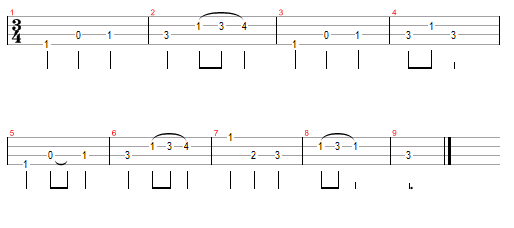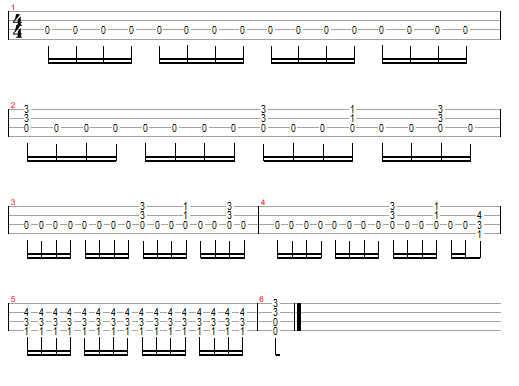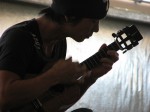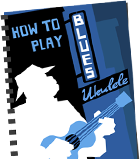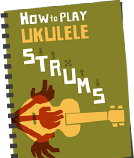Quick note: There’s a problem with the daily Uke Hunt emails at the moment and a lot of them aren’t getting through or sent. If the problem doesn’t right itself soon, I’ll try to make alternative arrangements. On to the matter in hand:
Phredd is one of my favourite YouTube ukers. His videos often leave me laughing so hard I need medical attention. Which says something about my maturity as Phredd (or Fred McNaughton) is children’s entertainer. I grilled him for more information.
How long have you been playing the uke? What attracted you to it?
I have been playing the uke about 5 or 6 years now. I love the sound. I bought one on a whim on ebay. It was a martin backpacker and I got it (with shipping) for $60. It was the sound I was looking for. It is just so happy. I have played all kinds of musical instruments my whole life, but none resonate with me more than the uke. When I started playing my ukulele at concerts, the kids loved it. Children really identify with the ukulele. They love how small it is and the happy sound it makes. Plus, everyone is playing the guitar, so it is unique.
How do you get into making music for kids?
I used to sing for adults. Then I started leading worship for kids at church and it just clicked. I didn’t find a lot of songs that I really liked, that had a lot of fun and enthusiasm, so I started writing my own and making up goofy hand motions to get the kids involved. Kids love to sing and love to worship, but they want to do it with their entire beings. So getting them jumping and moving and clapping and yelling is a big part of it. My wife and I have 8 children. Our oldest will be 26 in June. Our youngest, and newest member is 7. We just adopted her and have fallen in love with her. So we do a lot of singing at home. Through the years I would know I hit on a good song when I caught the kids singing it around the house. Then as they grew up they started helping me at the concerts, and that has been fantastic.
Something I find very interesting is that kids understand. They understand that you can be totally goofy and having fun and that some of the songs are just for making you smile and some of the songs have a message. Adults seem to have trouble with that. If you are going to sing me a serious song then stop goofing around. That seems to be just as prevalent in church as not in church. But kids get it. I also am amused that the same songs I sang for adults,that they didn’t understand, they now appreciate and enjoy, because I am singing for their kids. So, it kind of changed everything for me in that sense. So, I guess you could say in some way, that I do kids songs for adults, too.
What’s the secret to keeping kids entertained?
When I find this out I will get back to you. Seriously, I’m not sure there is a secret. Sometimes it works and sometimes it doesn’t and I’m not sure it is always dependent on the performer. It might have more to do with what they ate, where they were before hearing you sing, or a hundred other things that affect kids. For me, having fun, acting goofy and just being my weird self seems to be the ticket.
How does your Christianity influence your music?
I love Jesus with all my heart, so it influences everything I do. I love singing for kids and making them smile. I think that is a gift from God. What could be better than singing for kids? At the same time, I think a lot of music for kids disrespects their musical appreciation. So I try to write songs that are fun and out of left field. For instance I have a song that is called Awooga. It replaces saying ‘Amen’ with saying ‘Awooga. So, if you say Amen at your church when the Pastor says something you approve of, imagine saying, “AWOOGA!” really loud at the top of your lungs instead. I tell the kids its like honking the horn of your car in approval. Kids seem to get that.
I also have a song called INVISIBLE FRIEND. I think kids (and big kids too) struggle with not being able to see God like we see each other. It’s that whole faith thing. Almost all of us had an imaginary friend at some point in our lives, so relating that to God being invisible, but not imaginary seemed like a fun way to help them understand a little bit.
I’ve also started to get into some of the older folk gospel spirituals. There was some great songwriting and story telling. I like how they didn’t tell the whole story, but told just enough that it makes you more interested. The song MARY DON’T YOU WEEP is one of my current favorites. That song is so excellently written, but it doesn’t hit you over the head. It makes you really think. It also conveys such a depth of emotion. I think some of our modern music has lost the ability to touch the soul, while at the same fueling our imagination, and tickling our funny bone. I like that about some of the older songs I am finding. They have a depth of feeling while at the same time not taking themselves so seriously. Something about that really appeals to me. I don’t know if you’ve seen Bruce Springsteen and the Sessions Band Live in Dublin or not, but, wow! I love that dvd and I have been watching and listening to it a ton.
Elmer’s Electric Tricycle is my absolute favourite. Is it a true story? (Asked more in hope than expectation).
My very good friend Steven Courtney and I wrote this song together. Steven also performs for children and families and is about the best friend anyone could ever have.
We both have very busy schedules so we don’t get to spend as much time together as we would like. We also really enjoy writing songs and making music together. So one time, we came up with this crazy idea to write songs together via email. I would send him a line, and then maybe later that day, or the next, he would send me the next line. I do a morning radio show, so I wake up very early, and I would come in to work and open my email and there would be the next line to the song and it would make me really laugh. So our goal became to make the other person laugh when they read the next line. We wrote over 40 songs together that way. It was just a really fun time.
Elmer’s was born out of that writing experiment. In a weird sort of way it mirrored what we were doing with the songwriting; going into “the lab” and coming out with this explosion of creativity. The video of Elmer that you currently have up at Uke Hunt is my daughter Keilah and I singing. Keilah has been singing with me since she was about 7. We do about 50 concerts a year at schools, churches, festivals and all sorts of places. She is so talented and adds so much to this song and to the concerts in general. I love that she sings with me. It really is an honor to have my teenage daughter be my singing partner. Teenagerdom is a time when many kids are embarrassed by their parents, so I don’t take it for granted that Keilah, at the age of 16 is willing to make a fool of herself with me in front of an audience. That has been a huge blessing in my life.
Visit Phredd Central to find out more, hear more songs and buy his stuff. You can listen to Fred’s radio show, Get Up and Go, on WJTL FM 90.3.
